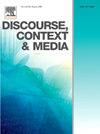Digital panda nationalism: Constructing nationalist discourse through metaphors in Chinese social media
IF 3.1
2区 文学
Q1 COMMUNICATION
引用次数: 0
Abstract
By analyzing the metaphors used in Weibo discussions about the giant panda Ya Ya’s travails in the United States in 2023, this study illuminates how Chinese netizens construct nationalist discourse on social media platforms. Employing the method of Critical Metaphor Analysis (CMA), we explore how nationalism is articulated through both personification and de-personification discourse strategies in the shape of metaphor. We find that the giant panda, as China’s national symbol, is personified to evoke empathy and to unite Chinese netizens in opposition to the United States. This personification also serves to map China’s humiliating historical experiences with its powerful present, reinforcing national dignity. The binary personification of a positive in-group (China) versus a negative out-group (the United States) strengthens Chinese netizens' national identity. Meanwhile, the United States and its citizens are degraded as negatively connotated animals such as dogs and pigs, objects such as rubbish and mildew, and even evil, through dehumanizing metaphors. Mediated by Weibo mechanisms, dichotomous discourse amplifies the spread of nationalism and mobilizes netizens to engage in petitions. Overall, this study contributes to understanding digital nationalism and Sino-US relations from a micro-discursive perspective.
数字熊猫民族主义:通过隐喻构建中国社交媒体中的民族主义话语
本研究通过分析2023年大熊猫“丫丫”在美国遭遇的微博讨论中使用的隐喻,说明中国网民如何在社交媒体平台上构建民族主义话语。本文运用批判隐喻分析的方法,探讨了民族主义是如何通过隐喻形式的拟人化和去拟人化话语策略来表达的。我们发现,大熊猫作为中国的国家象征,被人格化是为了唤起共鸣,团结中国网民反对美国。这种人格化也有助于将中国屈辱的历史经历与强大的现在联系起来,增强民族尊严。积极的内群体(中国)和消极的外群体(美国)的二元人格化强化了中国网民的国家认同。与此同时,通过非人性化的隐喻,美国及其公民被贬低为具有负面内涵的动物,如狗和猪,垃圾和霉菌等物体,甚至邪恶。在微博机制的中介下,二元话语放大了民族主义的传播,动员网民参与上访。总体而言,本研究有助于从微观话语的角度理解数字民族主义与中美关系。
本文章由计算机程序翻译,如有差异,请以英文原文为准。
求助全文
约1分钟内获得全文
求助全文

 求助内容:
求助内容: 应助结果提醒方式:
应助结果提醒方式:


